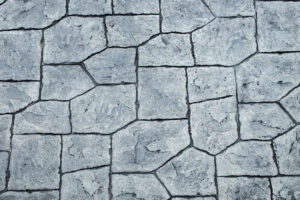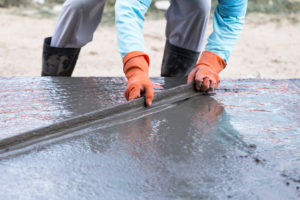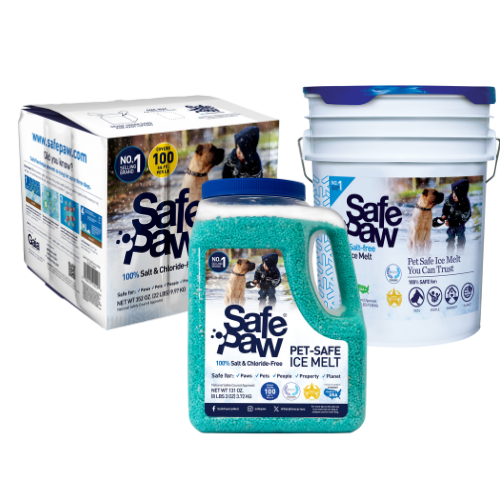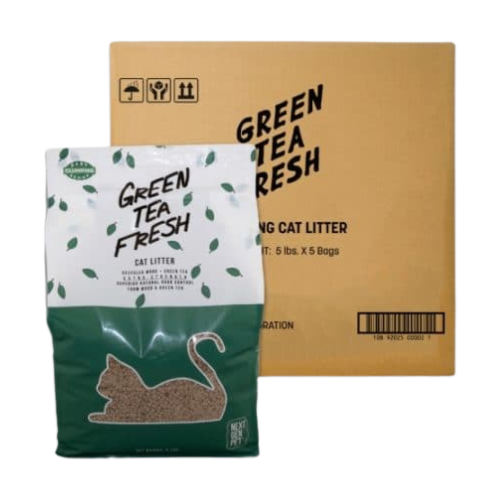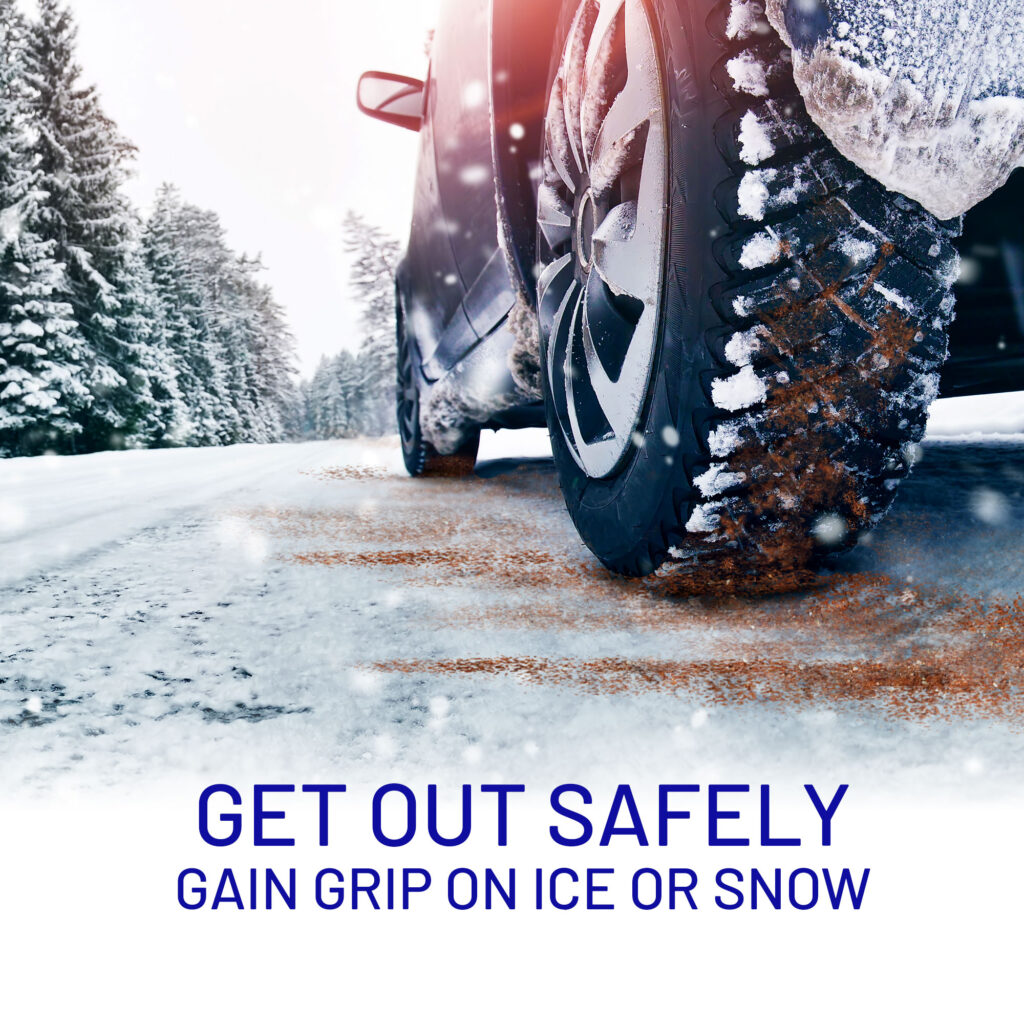Snow Forecast: The Right Ice Melt for Stamped Concrete Surfaces
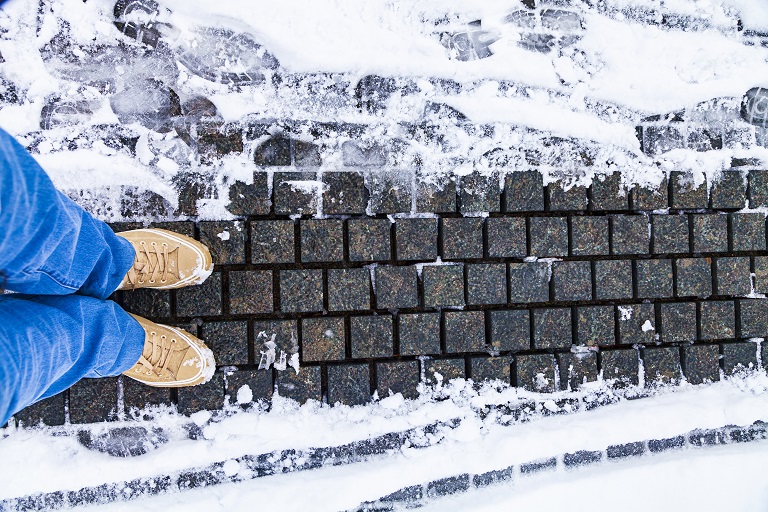
Stamped concrete is a very popular and relatively inexpensive way to add character to a home. Its low maintenance and durability have made it very popular for sidewalks, driveways, patios, and other outdoor surfaces. Its nearly limitless patterns and color options make it one of the most versatile materials on the market. While well cared for stamped concrete surfaces can be very attractive, poorly, or wrongly maintained, stamped concrete can be one of the most hideous and repulsive things in the world of homeownership.
How To Get The Best-Stamped Concrete?
The stamp placed over the imprinted concrete creates the patterns. The shape of these patterns is similar to that of natural building material. Imprinting over the concrete is done with a concrete stamp after it has been poured and leveled.
The most recent and modern concrete stamps are Polyurethane. Previously, these were metals. If the imprinting process is not done correctly, it’s exceedingly difficult and expensive to fix.
Each stamp goes together in a specific way, and you can’t go back and start again if you mess up the design or get offline with the stamps once you start printing. Liquid rubber can also make a homemade concrete stamp, although this adds to the project’s complexity.
Advantages Of Stamped Concrete
Ice Melt Safe For Concrete
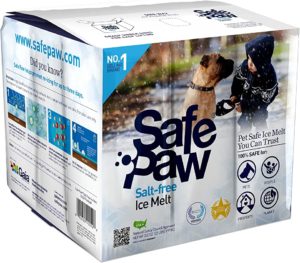
Pet Friendly Ice Melt – Safe Paw!
The Original and the #1 Child and Pet Safe Ice Melt for over 20 years. Guaranteed environmentally safe – will not harm waterways and sensitive wetlands.
Problems With Stamped Concrete
Even though stamped concrete is durable and beautiful but is not free from issues. Some of the common stamped concrete problems are;
- Over time, stamped concrete will crack. When exposed to freezing and thawing cycles, it will crack and shift over time.
- Stamped concrete, especially when wet, can be slick. It is mainly the result of the stamped concrete’s surface treatment.
- On a colorful patio, getting the correct coloring can be difficult. The mixed concrete color may be slightly different than expected by the customer. There are chances of variation in color of which you choose and what you get.
- Repairing or changing stamped concrete is cumbersome. A concrete pad is permanent once laid and cured (dried) in place. Surface flaws chipped corners and edges, and puddling concerns are not repairable.
- Ice cannot be removed from stamped concrete using salt. If exposed to concrete, the chemical component in salt will cause the concrete’s surface to chip and shatter. It makes it difficult to remove snow and ice from the textured surface. Avoid shoveling on stamped concrete.
Stamped Concrete Driveway Cost.
Would you like to know the cost of a stamped concrete driveway? The price might be different depending on various factors such as size, customization and location. However, the normal prices range from $12 to $18 per square foot. If you choose complicated designs or premium finishes, expect higher costs. Isn’t it worth considering how much that initial outlay could enhance the curb appeal of your home?
Stamped Concrete Driveway Colors
It’s so amazing that choosing color of your stamped concrete driveway can be fun filled. Do you know that grey is not the only color available for concrete? From the warm terracotta to deep charcoal varieties are endless. These colors can be achieved by adding pigments during mixing or applying stains and dyes post-installation thereby perfectly blending with your house’s exterior.
Stamped Concrete Driveway Patterns
Which patterns are trending in stamped concrete driveways? There is a broad range! Natural stone, brick or even complex cobblestone are some of the patterns amongst which one can select. Every pattern adds a distinctive feel as well as appearance that significantly improves how appealing your property looks like. Have you ever pondered upon how a Herringbone pattern or Slate impression could change the look of your driveway?
Benefits of Stamped Concrete Driveways
Considering a stamped concrete driveway? They offer more than just beauty. These driveways are known for their longevity and low maintenance. They don’t settle or shift like pavers might, ensuring stability. Plus, they resist weed growth and are easy to clean—just sweep and wash away any debris. Perfect for busy homeowners who still desire that upscale look, don’t you think?
Stamped Concrete vs Pavers Driveway
Debating between stamped concrete and pavers for your driveway? Each has its merits. Stamped concrete is generally more cost-effective and quicker to install than pavers. However, pavers offer a richness in texture and color that’s hard to beat, along with easier repairs since individual pavers can be replaced. Consider your budget, aesthetic preferences, and how much maintenance you’re willing to undertake. Which option fits your lifestyle better?
Exploring these options allows you to make informed decisions tailored to your specific needs, enhancing not just your home’s functionality but also its aesthetic appeal. Have you considered how these choices align with your home improvement goals?
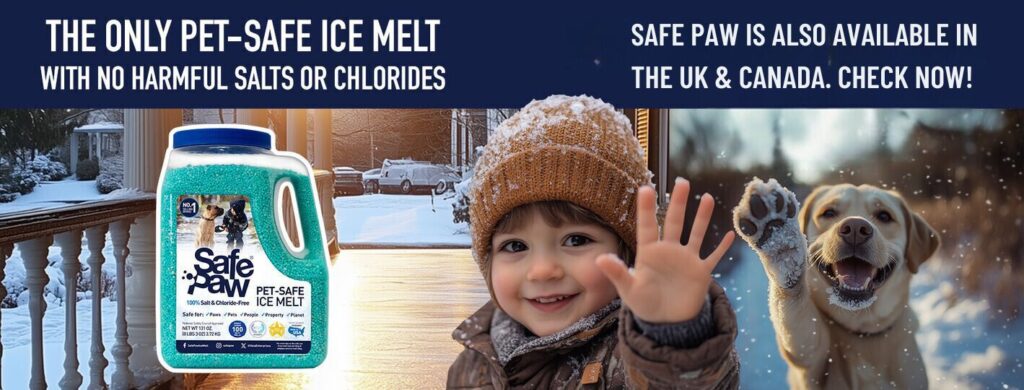
Stamped Concrete Driveway Cost.
Would you like to know the cost of a stamped concrete driveway? The price might be different depending on various factors such as size, customization and location. However, the normal prices range from $12 to $18 per square foot. If you choose complicated designs or premium finishes, expect higher costs. Isn’t it worth considering how much that initial outlay could enhance the curb appeal of your home?
Stamped Concrete Driveway Colors
It’s so amazing that choosing color of your stamped concrete driveway can be fun filled. Do you know that grey is not the only color available for concrete? From the warm terracotta to deep charcoal varieties are endless. These colors can be achieved by adding pigments during mixing or applying stains and dyes post-installation thereby perfectly blending with your house’s exterior.
Stamped Concrete Driveway Patterns
Which patterns are trending in stamped concrete driveways? There is a broad range! Natural stone, brick or even complex cobblestone are some of the patterns amongst which one can select. Every pattern adds a distinctive feel as well as appearance that significantly improves how appealing your property looks like. Have you ever pondered upon how a Herringbone pattern or Slate impression could change the look of your driveway?
Pet Safe Ice Melt – Safe Paw
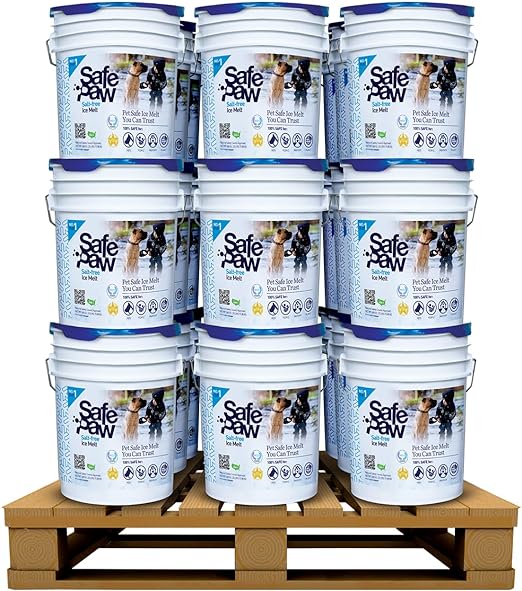
Safe Paw, Child Plant Dog Paw & Pet Safe Ice Melt -35lb, 36 Pails

Safe Paw, Child Plant Dog Paw & Pet Safe Ice Melt -22lb, 100Bboxes
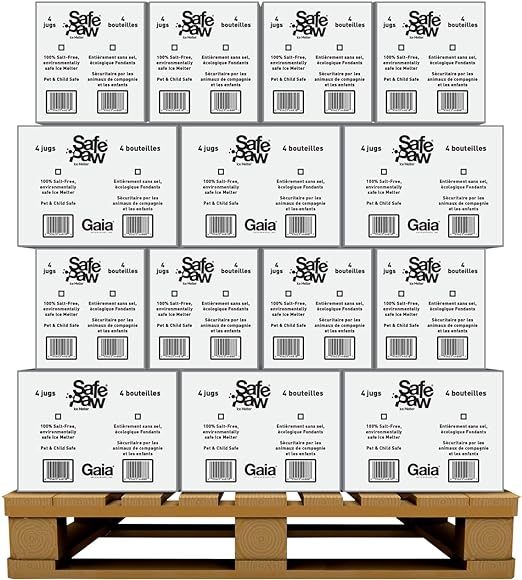
Safe Paw, Child Plant Dog Paw Pet Safe Ice Melt, 160 Jugs
Pet Products Powered By EzPz.pet
Benefits of Stamped Concrete Driveways
Considering a stamped concrete driveway? They offer more than just beauty. These driveways are known for their longevity and low maintenance. They don’t settle or shift like pavers might, ensuring stability. Plus, they resist weed growth and are easy to clean—just sweep and wash away any debris. Perfect for busy homeowners who still desire that upscale look, don’t you think?
Stamped Concrete vs Pavers Driveway
Debating between stamped concrete and pavers for your driveway? Each has its merits. Stamped concrete is generally more cost-effective and quicker to install than pavers. However, pavers offer a richness in texture and color that’s hard to beat, along with easier repairs since individual pavers can be replaced. Consider your budget, aesthetic preferences, and how much maintenance you’re willing to undertake. Which option fits your lifestyle better?
Exploring these options allows you to make informed decisions tailored to your specific needs, enhancing not just your home’s functionality but also its aesthetic appeal. Have you considered how these choices align with your home improvement goals?
Common Mistakes
The most common mistake most people make is using salt-based ice melt to remove the ice. While this seems completely harmless at first, once the ice is gone you’ll notice blotches on the concrete that look very similar to hard water stains. These apparent stains come from the chemicals in the ice melt reacting with the dyes used to color the surface in much the same fashion as bleach. These blotches cannot be removed or covered over. The only way to fix this problem is to break up the whole surface and re-pour it, which is expensive and time-consuming.
- Incorrect Application
When using any ice melt product, it is critical to read the application instructions. To make things simple all of the directions are stated clearly on the package itself. The usage of gloves while applying magnesium chloride or calcium chloride ice melt is clearly stated in the instructions. It also warns against using the chemical to melt ice on the roof since it could damage the material. When rock salt is put on stamp concrete driveways or walkways, it eventually finds its way into a drainage system, making it even more dangerous. Ice and snow expand and contract when they thaw and refreeze, thus damaging the stamped concrete. Hence, use an ice melt that minimizes the freeze-thaw side effects.
- Using The Wrong Ice Melt
Because there are so many ice-melts on the market, there’s a risk you’ll pick the wrong one. It’s because potassium chloride, sodium chloride, urea, calcium chloride, and magnesium chloride make up the majority of ice melts on the market.
There are products in the market, such as Safe Paw, that are chloride-free, salt-free, and environmentally friendly. These qualities make them the best snow melt on the market.
Heat-releasing deicers melt ice the fastest, but their rapid expansion and contraction can harm your surface.
Choosing an ice melt that is appropriate for your location, climate, and environment will go a long way toward determining its effectiveness.
- Not Cleaning Up
The potential harm to the surface caused by tracked-in ice melt or remaining ice melt is greater in general. Many ice melts leave a powdery or yellowish residue in the area where they were applied. It’s not only unsightly, but it’s also dangerous to the environment.
If left on the surface for too long, magnesium and calcium chloride ice melt produce an oily coating that can impair the wax finish of your wooden floors. Furthermore, the greasy residue may cause you more harm than good if you slip on it. If you forget to remove any of the remains, Your concrete or flooring will be damaged by the ice melt residue.
- Not Using The Ice Melt.
As an alternative to ice melt for stamped concrete, many individuals choose to use kitty litter, sand, or sawdust. While it isn’t horrible, it isn’t the most popular method for dealing with slick surfaces. Unfortunately, failing to use a concrete-safe ice melt will put your health at risk more than anything else. Winters are not free from woes since your slipping, falling, or skidding risks increase dramatically. It can be a costly blunder. Using kitty litter or sawdust can result in a sloppy home because it eventually leaves a messy residue on the rugs and carpets. Some people believe that utilizing ice melt is not beneficial for the environment, so it’s best to stay away from it.
It is a common misconception that shoveling snow after a snowstorm is sufficient. Your stamping concrete sidewalk is more secure to walk after the use of ice melt.
Snow and ice melting products that are environmentally and pet-friendly will help you combat the winter blues and save you a lot of work.
Prevention
As with most problems, prevention is the best medicine. Some surfaces that are unlikely to be used, such as gazebo floors, can be covered with tarps before the first snow falls, to provide a barrier between the ice and the concrete. This will also eliminate the need to shovel these areas, as the snow can be left to melt in the springtime. For areas that will be in use during the winter, you need to choose the best ice melt for concrete, such as Safe Paw Ice Melt, to prevent discoloration.
Winter Safety & Ice Melt Considerations
Winter safety especially for homeowners involves more than just staying warm. It’s about ensuring that every step outside your home is secure and free from ice-related hazards. Utilizing an ice melt that won’t damage concrete is essential, especially for those with newly poured driveways or sidewalks. Not all ice melters are created equal—concrete friendly ice melt options are formulated to effectively melt ice without contributing to the deterioration of concrete surfaces through harsh chemical reactions.
Sand as a Safe Traction Alternative
While sand doesn’t melt ice, it plays a crucial role in winter safety by providing traction on icy surfaces. Unlike calcium chloride or other harsh chemicals, sand will not cause chemical damage to concrete. It’s an environmentally friendly choice that can be easily applied and cleaned up, making it a practical solution for immediate slip prevention.
DIY Ice Melt Solutions for Concrete Safety
Creating your own ice melt that is safe for concrete involves simple, household ingredients that are less corrosive than commercial products. A popular DIY recipe includes mixing common salt with sand or coffee grounds to reduce the salt’s concentration, thereby minimizing its potential harm to concrete while still lowering the freezing point of water on surfaces. This method provides a more concrete-friendly ice melt solution, ensuring that you protect both your property and the environment.
The Importance of Selecting the Right Ice Melter for Concrete
Choosing the right ice melter is vital for maintaining the integrity of your concrete during cold months. Ice melt products for concrete should have a balanced formula that can effectively melt ice without causing scaling or spalling. Products like Safe Paw are specifically designed to be safe for concrete, pets, and the environment, offering a reliable solution without the detrimental effects associated with calcium chloride and other intense chemical melters.
Tips for Application
When applying ice melt, it’s crucial to follow best practices to avoid overuse, which can lead to unnecessary concrete damage. Spread the ice melt evenly across icy areas using a handheld or wheeled spreader to ensure uniform coverage. Start with a small amount and add more if necessary, depending on the ice thickness and external temperature conditions.
By focusing on these aspects, you can enjoy a safer winter environment around your home while preserving the condition of your concrete surfaces. Each of these methods provides a way to combat winter’s challenges effectively and safely, ensuring that your property remains intact and hazard-free.
Salts To Avoid On Stamped Concrete
Salt Combinations
A growing number of salt mixtures are used around the country, with many of them developed in response to the detrimental environmental effects of salt. One such mixture is potassium and sodium chloride.
Salt Free Ice Melt
Homeowners with stamped concrete should avoid salt-based ice melt at all cost. The results of long-term use are much more expensive and inconvenient than simply switching over to a concrete safe ice melt such as Safe Paw.
It has a unique combination that combines two ice-fighting chemicals, each with its function. When the innovative outer core comes into touch with ice, it instantly liquefies. It starts to melt, breaking up the slick ice surface. It enables the crystalline amide core to penetrate deep into the ice. Thus the melting process is completed providing you with long-term protection.
Glycol used to defrost the ice and prevent additional freezing is included in Safe Paw’s proprietary composition. As a result, Safe Paw not only melts current ice but also protects the surface to prevent ice from accumulating in the future.
Chloride-Free And Non-Toxic
Safe Paw is a chloride-free, non-toxic ice melt. Most ice melting salts contain chloride in some form or another. These harmful compounds cause discomfort and itching in our four-legged pals’ paws. They may also erode driveways and paths. To keep your winters clean and safe, we have Safe Paw ice melt. It is safe, non-toxic, chloride-free, and keeps ice and snow from sticking to the surface.
Your ideal ice melter should also be capable of acting as a pre-treatment. Few ice melts can prevent ice from sticking to surfaces for up to three days after usage. Safe Paw works for three days to keep you from becoming stuck.
The Ability To Prevent The Freeze-thaw Cycle
Safe Paw will keep melting ice in a liquid state for a longer time, preserving and extending the life of your concrete. It means that when the ice melts, it will not refreeze as frequently, effectively ending the freeze-thaw cycle. It will keep your rock-stamped concrete safe from winter hazards.
Pet-Friendly Ice Melt
Some of the most popular goods you’ve heard about are dangerous to use. Chloride, which is hazardous to pets, is found in the majority of them. They can cause skin irritation, eye, nose, and lung burning. Safe Paw is an ice melt solution that will not burn or harm your pet’s paws if swallowed. It does not include any salt.
Conclusion
While utilizing the correct snow-melt solution is an excellent approach to protect anybody who comes into touch with snow-covered concrete, it’s also crucial to consider the concrete’s safety while making your decision.
A stamped concrete driveway or sidewalk is a substantial investment for any homeowner, and winter can be brutal on concrete. The freezing and thawing cycle can create significant cracking, requiring costly repairs in the spring. Furthermore, one of the most often used de-icers, rock salt, affects concrete by increasing water absorption, which causes cracking and surface damage due to the freeze-thaw cycle. Hence, it is advisable to use salt-free, natural ice melt on stamped concrete.
FAQs
Stay safe and confident this winter with Traction Magic!
This innovative, 100% natural product offers instant traction on any icy surface. Whether you’re navigating your sidewalk, steps, or driveway, Traction Magic helps you stay upright and prevents falls.
Other Ice Melt Products
Walk On Ice
Prevent slips at home, work or on the go, The handy disposable canister can be taken everywhere, with the same 100% naturally occurring minerals that provide instant traction on ice or snow.
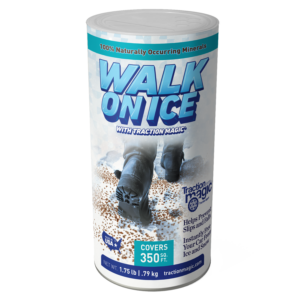
Safe Thaw
Imagine an ice melt you can put down and never worry about. It won’t harm pets, kids and your property. That’s Safe Thaw. Unlike anything else on the market, Safe Thaw can change how winter affects our planet.
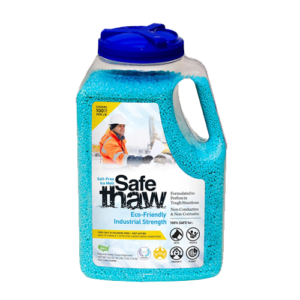
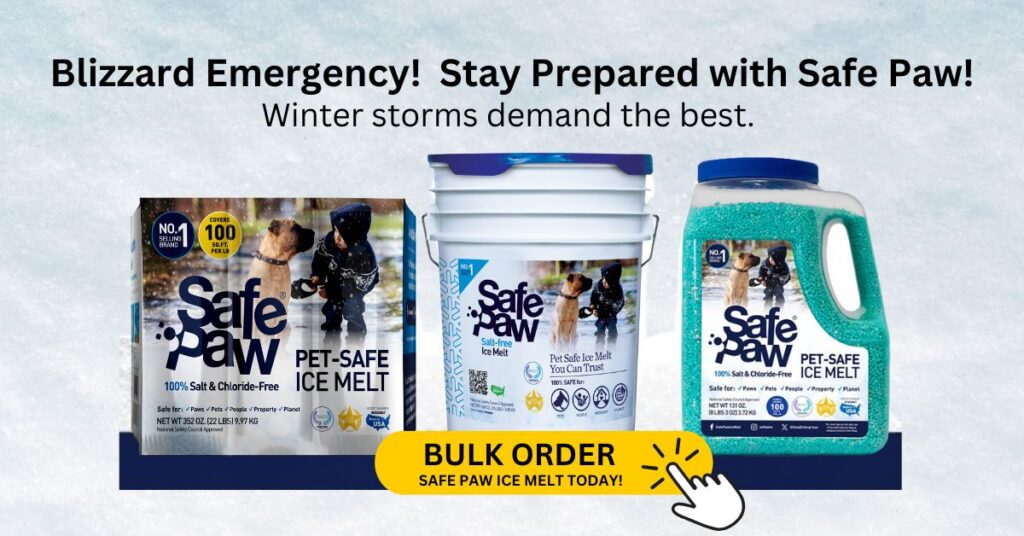

Author: Shweta Saxena
Shweta, a passionate pet lover and environmental advocate, has dedicated herself to promoting winter safety for pets. Living amidst the scenic, snowy landscapes of Canada, she expertly merges her love for animals with her exceptional writing talents. Her commitment is deeply rooted in ensuring the well-being of pets during the harsh winter months.


